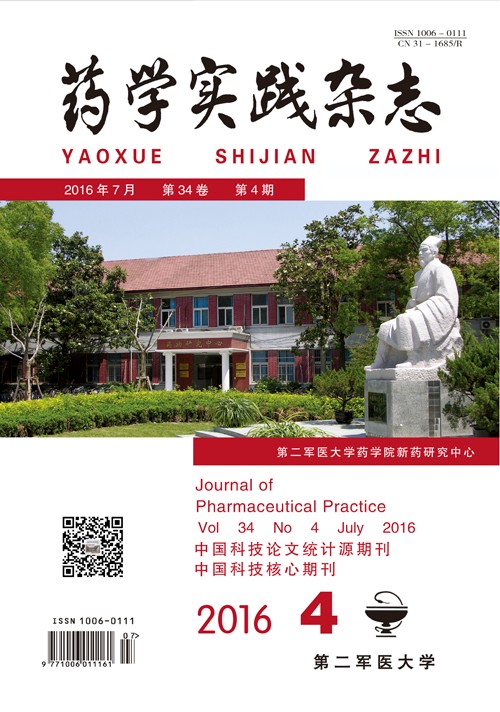CHEN Ling, LI Chunyan, WANG Zheng, JIA Min, HAN Ting. Quantitation of nine ginsenosides in Panax ginseng hairy roots and other Panax ginseng plant components by HPLC[J]. Journal of Pharmaceutical Practice and Service, 2016, 34(4): 313-317,353. doi: 10.3969/j.issn.1006-0111.2016.04.007
| Citation:
|
CHEN Ling, LI Chunyan, WANG Zheng, JIA Min, HAN Ting. Quantitation of nine ginsenosides in Panax ginseng hairy roots and other Panax ginseng plant components by HPLC[J]. Journal of Pharmaceutical Practice and Service, 2016, 34(4): 313-317,353. doi: 10.3969/j.issn.1006-0111.2016.04.007
|
Quantitation of nine ginsenosides in Panax ginseng hairy roots and other Panax ginseng plant components by HPLC
-
Department of Pharmacognosy, School of Pharmacy, Second Military Medical University, Shanghai 200433, China
- Received Date: 2016-01-26
- Rev Recd Date:
2016-05-03
-
Abstract
Objective To establish an HPLC method for the quantitation of nine ginsenosides (Rc,Rb1,Rb2,Re,Rd,Rg1,Rg2,Rg3 and Rh2) in Panax ginseng samples. Methods An HPLC method was developed to determine the quantities of the nine ginsenosides. The determination was performed on a Zorbax SB C18 column (4.6 mm×250 mm,5 μm) with an Extend-C18 guard column (4.6 mm×12.5 mm,5 μm) at 35℃. The mobile phase was a multi-step acetonitrile-water gradient run at a flow rate of 1.0 ml/min. The detection wavelength was 203 nm. Results The nine ginsenosides were baseline separated within 120 min. The method had good linearity, precision, stability and reproducibility with RSDs all less than 2.0%. The sample recoveries were between 98.3% to 102%. The quantity of total saponins in leaves and fibrous roots of Panax ginseng, which were measured as 48.9 mg/g and 23.6 mg/g, respectively, were higher than those in the other plant components. The amounts of total saponins in Panax ginseng hairy roots were similar to those in taproots and fruits of Panax ginseng, which was 7.47 mg/g. Conclusion The established HPLC method is accurate, simple, rapid, precise and reproducible and could be used for the quantitation of these nine ginsenosides in Panax ginseng samples.
-
References
|
[1]
|
张国华, 李绍平, 万建波, 等. RP-HPLC法测定三七总皂苷注射液中9 种皂苷的含量[J]. 安徽医药, 2005, 9(9):664-665. |
|
[2]
|
黄连玉. 浅析人参的化学成分及药理作用[J]. 中华现代中西医杂志, 2005, 2:10-18. |
|
[3]
|
张前进. 人参的化学成分和药理活性[J]. 光明中医, 2011, 26(2):368-369. |
|
[4]
|
Ming QL, Su CY, Zheng CJ, et al. Elicitors from the endophytic fungus Trichoderma atroviride promote Salvia miltiorrhiza hairy root growth and tanshinone biosynthesis[J]. J Exp Bot, 2013, 64(18):5687-5694. |
|
[5]
|
刘竣, 丁家宜, 徐红, 等. Ri质粒人参转化系统的建立及鉴定[J]. 中国中药杂志, 2001, 26(2):95. |
|
[6]
|
Aly A H, Debbab A, Proksch P. Fungal endophytes-secret producers of bioactive plant metabolites[J]. Pharmazie, 2013, 68(7):499-505. |
|
[7]
|
Kusari S, Hertweck C, Spiteller M. Chemical ecology of endophytic fungi:origins of secondary metabolites[J]. Chem Biol, 2012, 19(7):792-798. |
|
[8]
|
Kusari S, Pandey SP, Spiteller M. Untapped mutualistic paradigms linking host plant and endophytic fungal production of similar bioactive secondary metabolites[J]. Phytochemistry, 2013, 91:81-87. |
|
[9]
|
任跃英, 丛 林, 官秀芝, 等. 人参资源现状及可持续发展战略[J]. 人参研究, 2003, 15(4):9-10. |
|
[10]
|
郭凤霞, 陈路晓, 刘 斌, 等. 人参中人参皂苷类成分含量测定方法优化[J]. 环球中医药, 2015, 8(10):1175-1178. |
|
[11]
|
曲桂武, 夏学超, 潘丽丽, 等. 8 种人参皂苷在人参全草中的分布情况[J]. 中国实验方剂学杂志, 2015, 21(17):52-55. |
|
[12]
|
国家药典委员会. 中华人民共和国药典2015年版一部[S]. 北京:中国医药科技出版社, 2015:8-9. |
|
[13]
|
常振战, 果德安, 郑俊华.Ri质粒转化植物生产天然活性成分的研究进展(Ⅱ)[J]. 中草药, 1998, 29(11):775-777. |
-
-
Proportional views

-







 DownLoad:
DownLoad: